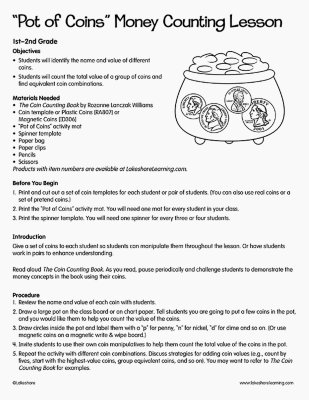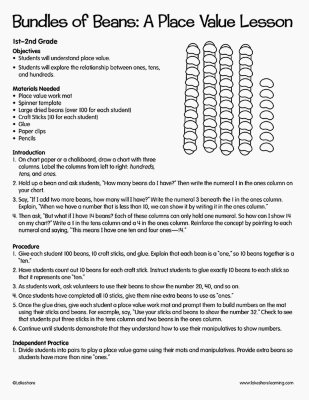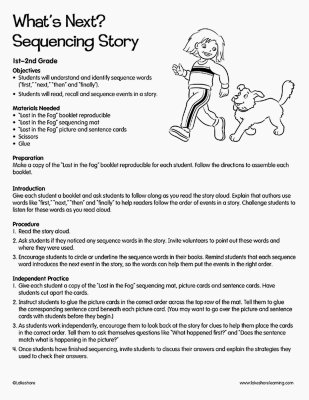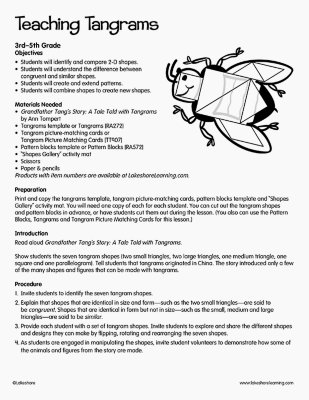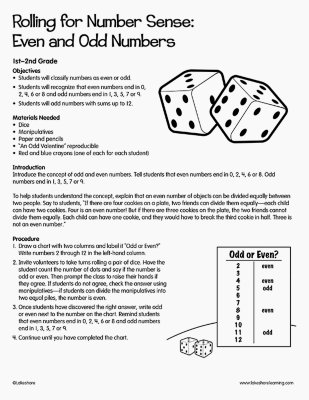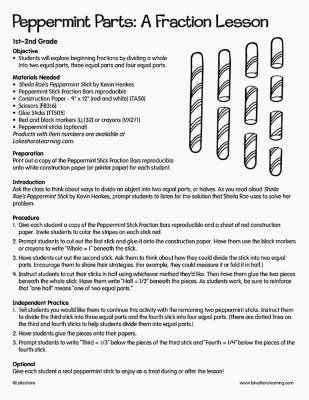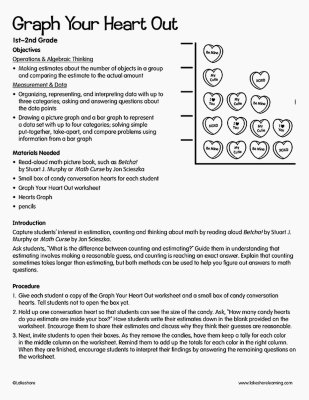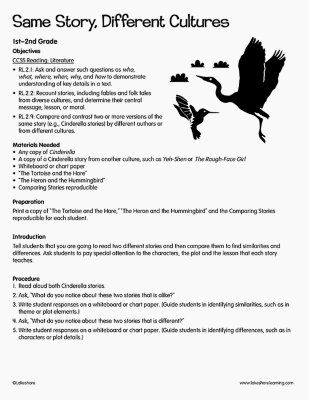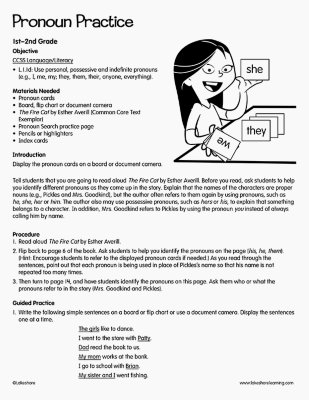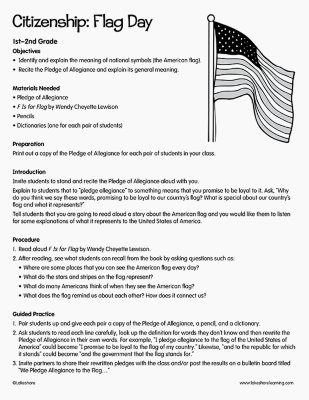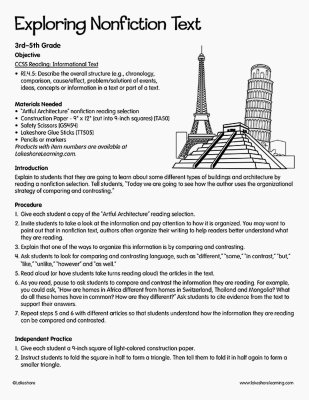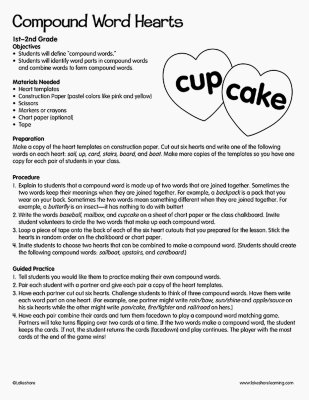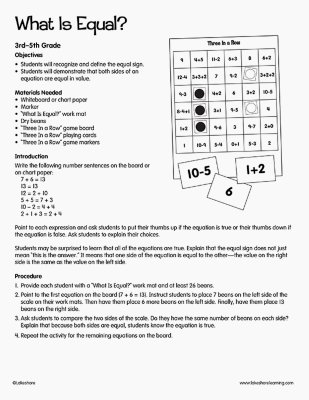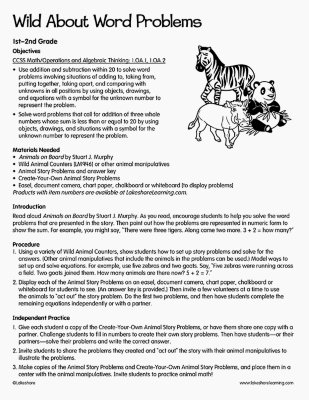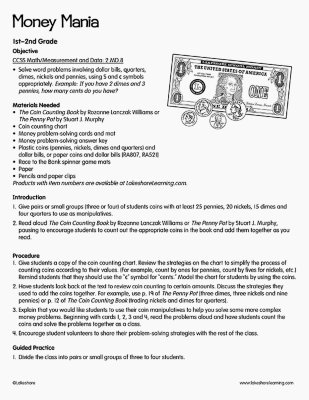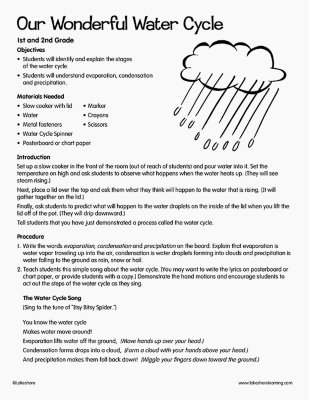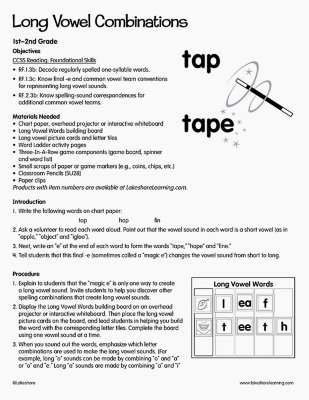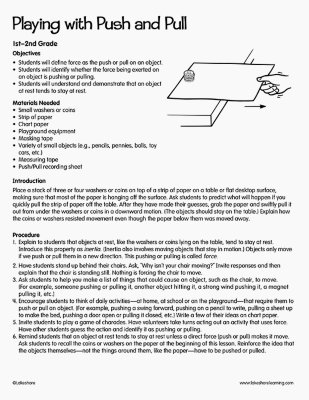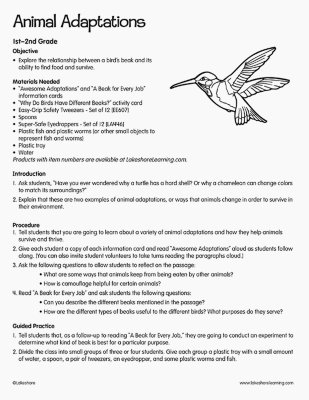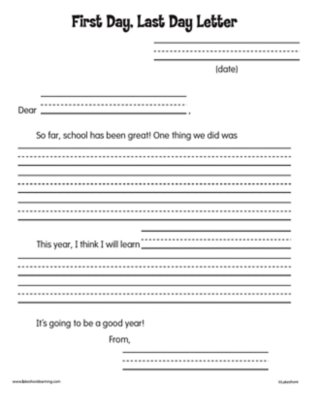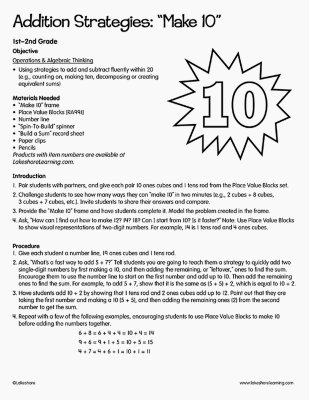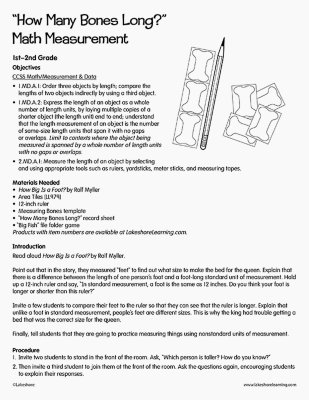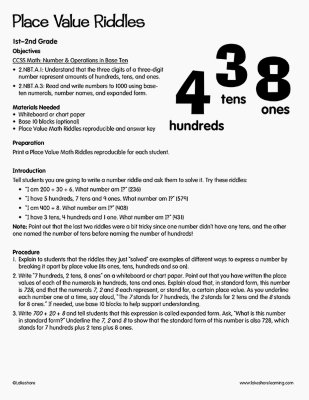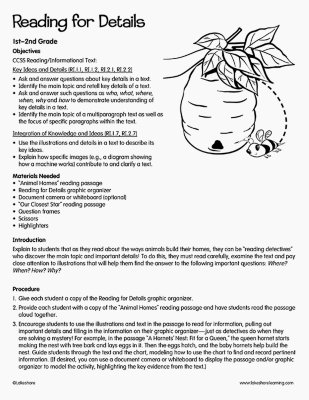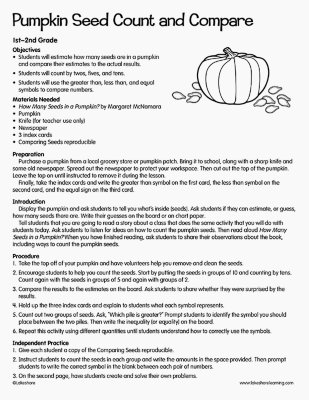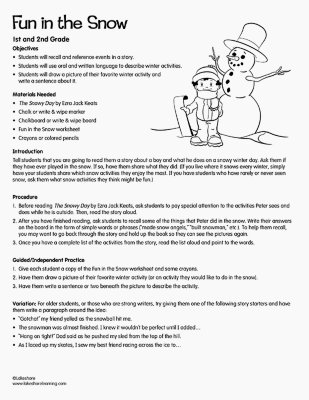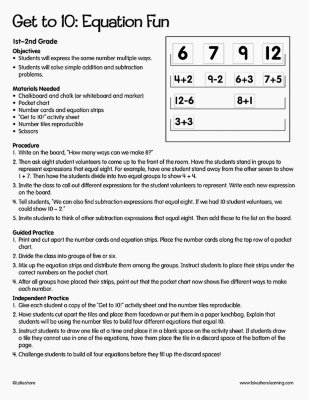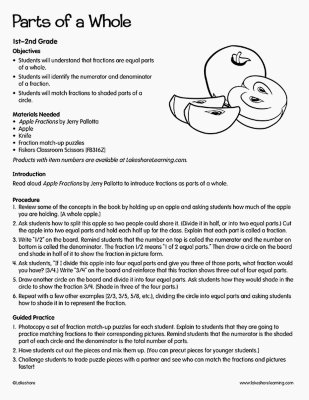Narrow by Grade
- Infant (0)
- Toddler (0)
- Preschool (0)
- Pre-K (0)
- Kindergarten (0)
- 1st (21)
- 2nd (30)
- 3rd (0)
- 4th (0)
- 5th (0)
- 6th & Up (0)
Grade
Narrow by Age
- 0-18m (0)
- 18-36m (0)
- 3 yrs. (0)
- 4 yrs. (28)
- 5 yrs. (38)
- 6 yrs. (38)
- 7 yrs. (30)
- 8 yrs. (33)
- 9 yrs. (32)
- 10 yrs. (10)
- 11 yrs. & Up (0)
Age 7 yrs.
30 results for "student"
ITEMS:
Filters
Clear All
"Pot of Coins" Money Counting Lesson
2nd Grade
Objectives Students will identify the name and value of different coins. Students will count the total value of a group of coins and find equivalent coin combinations. Materials Needed The Coin Counting Book by Rozanne Lanczak Williams Coin template or Plastic Coins or Magnetic Coins “Pot of Coins” activity mat Spinner template Paper bag Paper clips Pencils Scissors Before You Begin Print and cut out a set of coin templates for each student or pair of students. (You can also use real coins or a set of pretend coins.) Print the “Pot of Coins” activity mat. You will need one mat for every student in your class. Print the spinner template. You will need one spinner for every three or four students. Introduction Give a set of coins to each student so students can manipulate them throughout the lesson. Or have students work in pairs to enhance understanding. Read aloud The Coin Counting Book. As you read, pause periodically and challenge students to demonstrate the money concepts in the book using their coins.
View Lesson PlanBundles of Beans: A Place Value Lesson
1st Grade - 2nd Grade
Objectives Students will understand place value. Students will explore the relationship between ones, tens, and hundreds. Materials Needed Place value work mat Spinner template Large dried beans (over 100 for each student) Craft Sticks (10 for each student) Glue Paper clips Pencils Introduction On chart paper or a chalkboard, draw a chart with three columns. Label the columns from left to right: hundreds, tens, and ones. Hold up a bean and ask students, “How many beans do I have?” Then write the numeral 1 in the ones column on your chart. Say, “If I add two more beans, how many will I have?” Write the numeral 3 beneath the 1 in the ones column. Explain, “When we have a number that is less than 10, we can show it by writing it in the ones column.” Then ask, “But what if I have 14 beans? Each of these columns can only hold one numeral. So how can I show 14 on my chart?” Write a 1 in the tens column and a 4 in the ones column. Reinforce the concept by pointing to each numeral and saying, “This means I have one ten and four ones—14.”
View Lesson PlanWhat’s Next? Sequencing Story
1st Grade - 2nd Grade
Objectives Reading Literature Retelling stories and demonstrating understanding of the central message or lesson Describing characters, settings, and major events in a story, using key details Understanding and identifying sequence words (e.g., “first,” “next,” “then,” “finally”) Materials Needed Lost in the Fog booklet reproducible Lost in the Fog sequencing mat Lost in the Fog picture and sentence cards Best-Buy Scissors Lakeshore Glue Sticks Pencils Preparation Make a copy of the Lost in the Fog booklet reproducible, sequencing mat, picture cards and sentence cards for each student. Follow the directions to assemble each booklet. Introduction Give each student a booklet and ask students to follow along as you read the story aloud. Explain that authors use words like “first,” “next,” “then” and “finally” to help readers follow the order of events in a story. Challenge students to listen for these words as you read aloud.
View Lesson PlanTeaching Tangrams
2nd Grade
Objectives Students will identify and compare 2-D shapes. Students will understand the difference between congruent and similar shapes. Students will create and extend patterns. Students will combine shapes to create new shapes. Materials Needed Grandfather Tang’s Story: A Tale Told with Tangrams by Ann Tompert Tangrams template or Tangrams Tangram picture-matching cards or Tangram Picture Matching Cards Pattern blocks template or Pattern Blocks “Shapes Gallery” activity mat Scissors Paper & pencils Preparation: Print and copy the tangrams template, tangram picture-matching cards, pattern blocks template and “Shapes Gallery” activity mat. You will need one copy of each for each student. You can cut out the tangram shapes and pattern blocks in advance, or have students cut them out during the lesson. (You also can use the Pattern Blocks, Tangrams and Tangram Picture Matching Cards for this lesson.) Introduction Read aloud Grandfather Tang’s Story: A Tale Told with Tangrams. Show students the seven tangram shapes (two small triangles, two large triangles, one medium triangle, one square and one parallelogram). Tell students that tangrams originated in China. The story introduced only a few of the many shapes and figures that can be made with tangrams.
View Lesson PlanRolling for Number Sense: Even and Odd Numbers
1st Grade - 2nd Grade
Objectives Students will classify numbers as even or odd. Students will recognize that even numbers end in 0, 2, 4, 6 or 8 and odd numbers end in 1, 3, 5, 7 or 9. Students will add numbers with sums up to 12. Materials Needed Dice Manipulatives Paper and pencils “An Odd Valentine” reproducible Red and blue crayons (one of each for each student) Introduction Introduce the concept of odd and even numbers. Tell students that even numbers end in 0, 2, 4, 6 or 8. Odd numbers end in 1, 3, 5, 7 or 9. To help students understand the concept, explain that an even number of objects can be divided equally between two people. Say to students, “If there are four cookies on a plate, two friends can divide them equally—each child can have two cookies. Four is an even number! But if there are three cookies on the plate, the two friends cannot divide them equally. Each child can have one cookie, and they would have to break the third cookie in half. Three is not an even number.”
View Lesson PlanPeppermint Parts: A Fraction Lesson
2nd Grade
Objective Students will explore beginning fractions by dividing a whole into two equal parts, three equal parts and four equal parts. Materials Needed Sheila Rae’s Peppermint Stick by Kevin Henkes Peppermint Stick Fraction Bars reproducible Construction Paper - 9" x 12" (red and white) Scissors Glue Sticks Red and black markers or crayons Peppermint sticks (optional) Preparation: Print out a copy of the Peppermint Stick Fraction Bars reproducible onto white construction paper (or printer paper) for each student. Introduction Ask the class to think about ways to divide an object into two equal parts, or halves. As you read aloud Sheila Rae’s Peppermint Stick by Kevin Henkes, prompt students to listen for the solution that Sheila Rae uses to solve her problem.
View Lesson PlanGraph Your Heart Out
1st Grade - 2nd Grade
Objectives Operations & Algebraic Thinking Making estimates about the number of objects in a group and comparing the estimate to the actual amount Measurement & Data Organizing, representing, and interpreting data with up to three categories; asking and answering questions about the data points Drawing a picture graph and a bar graph to represent a data set with up to four categories; solving simple put-together, take-apart, and compare problems using information from a bar graph Materials Needed Read-aloud math picture book, such as Betcha! by Stuart J. Murphy or Math Curse by Jon Scieszka Small box of candy conversation hearts for each student Graph Your Heart Out worksheet Hearts Graph pencils Introduction Capture students’ interest in estimation, counting and thinking about math by reading aloud Betcha! by Stuart J. Murphy or Math Curse by Jon Scieszka. Ask students, “What is the difference between counting and estimating?” Guide them in understanding that estimating involves making a reasonable guess, and counting is reaching an exact answer. Explain that counting sometimes takes longer than estimating, but both methods can be used to help you figure out answers to math questions.
View Lesson PlanSame Story, Different Cultures
1st Grade - 2nd Grade
Objectives CCSS Reading: Literature RL.2.1: Ask and answer such questions as who, what, where, when, why, and how to demonstrate understanding of key details in a text. RL.2.2: Recount stories, including fables and folk tales from diverse cultures, and determine their central message, lesson, or moral. RL.2.9: Compare and contrast two or more versions of the same story (e.g., Cinderella stories) by different authors or from different cultures. Materials Needed Any copy of Cinderella A copy of a Cinderella story from another culture, such as Yeh-Shen or The Rough-Face Girl Whiteboard or chart paper “The Tortoise and the Hare” “The Heron and the Hummingbird” Comparing Stories reproducible Introduction Tell students that you are going to read two different stories and then compare them to find similarities and differences. Ask students to pay special attention to the characters, the plot and the lesson that each story teaches.
View Lesson PlanPronoun Practice
1st Grade - 2nd Grade
Use personal, possessive and indefinite pronouns (e.g., I, me, my, they, them, their, anyone, everything). Materials Needed: pronoun cards, board, flip chart or document camera; The Fire Cat by Esther Averill; Pronoun Search practice page; pencils or highlighters; index cards. Introduction: Display the pronoun cards on a board or document camera. Tell students that you are going to read aloud The Fire Cat by Esther Averill. Before you read, ask students to help you identify different pronouns as they come up in the story. Explain that the names of the characters are proper nouns (e.g., Pickles and Mrs. Goodkind), but the author often refers to them again by using pronouns, such as he, she, her or him. The author also may use possessive pronouns, such as hers or his, to explain that something belongs to a character. In addition, Mrs. Goodkind refers to Pickles by using the pronoun you instead of always calling him by name.
View Lesson PlanCitizenship: Flag Day
2nd Grade
Objectives Identify and explain the meaning of national symbols (the American flag). Recite the Pledge of Allegiance and explain its general meaning. Materials Needed Pledge of Allegiance F Is for Flag by Wendy Cheyette Lewison Pencils Dictionaries (one for each pair of students) Introduction Invite students to stand and recite the Pledge of Allegiance aloud with you. Explain to students that to “pledge allegiance” to something means that you promise to be loyal to it. Ask, “Why do you think we say these words, promising to be loyal to our country’s flag? What is special about our country’s flag and what it represents?” Tell students that you are going to read aloud a story about the American flag and you would like them to listen for some explanations of what it represents to the United States of America.
View Lesson PlanExploring Nonfiction Text
1st Grade - 2nd Grade
Objective CCSS Reading: Informational Text RI.4.5: Describe the overall structure (e.g., chronology, comparison, cause/effect, problem/solution) of events, ideas, concepts or information in a text or part of a text. Materials Needed “Artful Architecture” nonfiction reading selection Construction Paper - 9" x 12" (cut into 9-inch squares) Safety Scissors Lakeshore Glue Sticks Pencils or markers Introduction Explain to students that they are going to learn about some different types of buildings and architecture by reading a nonfiction selection. Tell students, “Today we are going to see how the author uses the organizational strategy of comparing and contrasting.”
View Lesson PlanCompound Word Hearts
1st Grade - 2nd Grade
Objectives Students will define “compound words.” Students will identify word parts in compound words and combine words to form compound words. Materials Needed Heart templates Construction Paper - 9" x 12" (pastel colors like pink and yellow) Scissors Markers or crayons Chart paper (optional) Tape Preparation Make a copy of the heart templates on construction paper. Cut out six hearts and write one of the following words on each heart: sail, up, card, stairs, board, and boat. Make more copies of the templates so you have one copy for each pair of students in your class.
View Lesson PlanMystery Coins
1st Grade - 2nd Grade
Objectives Number & Operations in Base Ten Understanding 10 as a bundle of ten ones Skip-counting by 5s, 10s, and 100s Measurement & Data Solving word problems involving dollar bills, quarters, dimes, nickels, and pennies, using $ and ¢ symbols Materials Needed Plastic coins (or paper coins reproducible and scissors) Coin Values reproducible Mystery Coins reproducible Chart paper Marker Introduction Hold up each coin and review its name and value. You may want to print out and display the Coin Values reproducible for students to use as a reference. Be sure to show students both sides of each coin, and remind them that larger coins do not necessarily have greater values.
View Lesson PlanWhat Is Equal?
2nd Grade
Objectives Students will recognize and define the equal sign. Students will demonstrate that both sides of an equation are equal in value. Materials Needed Whiteboard or chart paper Marker “What Is Equal?” work mat Dry beans “Three In a Row” game board “Three In a Row” playing cards “Three In a Row” game markers Introduction Write the following number sentences on the board or on chart paper: 7 + 6 = 13 13 = 13 12 = 2 + 10 5 + 5 = 7 + 3 10 - 2 = 4 + 4 2 + 1 + 3 = 2 + 4 Point to each expression and ask students to put their thumbs up if the equation is true or their thumbs down if the equation is false. Ask students to explain their choices. Students may be surprised to learn that all of the equations are true. Explain that the equal sign does not just mean “this is the answer.” It means that one side of the equation is equal to the other—the value on the right side is the same as the value on the left side.
View Lesson PlanWild About Word Problems
1st Grade - 2nd Grade
Objectives CCSS Math/Operations and Algebraic Thinking: 1.OA.1, 1.OA.2 Use addition and subtraction within 20 to solve word problems involving situations of adding to, taking from, putting together, taking apart, and comparing with unknowns in all positions by using objects, drawings, and equations with a symbol for the unknown number to represent the problem. Solve word problems that call for addition of three whole numbers whose sum is less than or equal to 20 by using objects, drawings, and situations with a symbol for the unknown number to represent the problem. Materials Needed Animals on Board by Stuart J. Murphy Wild Animal Counters or other animal manipulatives Animal Story Problems and answer key Create-Your-Own Animal Story Problems Easel, document camera, chart paper, chalkboard or whiteboard [to display problems] Introduction Read aloud Animals on Board by Stuart J. Murphy. As you read, encourage students to help you solve the word problems that are presented in the story. Then point out how the problems are represented in numeric form to show the sum. For example, you might say, “There were three tigers. Along came two more. 3 + 2 = how many?”
View Lesson PlanMoney Mania
2nd Grade
Objective CCSS Math/Measurement and Data: 2.MD.8 Solve word problems involving dollar bills, quarters, dimes, nickels and pennies, using $ and ¢ symbols appropriately. Example: If you have 2 dimes and 3 pennies, how many cents do you have? Materials Needed The Coin Counting Book by Rozanne Lanczak Williams or The Penny Pot by Stuart J. Murphy Coin counting chart Money problem-solving cards and mat Money problem-solving answer key Plastic coins (pennies, nickels, dimes and quarters) and dollar bills, or paper coins and dollar bills Race to the Bank spinner game mats Paper Pencils and paper clips Introduction Give pairs or small groups (three or four) of students coins with at least 25 pennies, 20 nickels, 15 dimes and four quarters to use as manipulatives. Read aloud The Coin Counting Book by Rozanne Lanczak Williams or The Penny Pot by Stuart J. Murphy, pausing to encourage students to count out the appropriate coins in the book and add them together as you read.
View Lesson PlanOur Wonderful Water Cycle
1st Grade - 2nd Grade
Objectives Students will identify and explain the stages of the water cycle. Students will understand evaporation, condensation and precipitation. Materials Needed Slow cooker with lid Water Posterboard or chart paper Marker Water Cycle Spinner Crayons Scissors Metal fasteners Introduction Set up a slow cooker in the front of the room (out of reach of students) and pour water into it. Set the temperature on high and ask students to observe what happens when the water heats up. (They will see steam rising.) Next, place a lid over the top and ask them what they think will happen to the water that is rising. (It will gather together on the lid.) Finally, ask students to predict what will happen to the water droplets on the inside of the lid when you lift the lid off of the pot. (They will drip downward.) Tell students that you have just demonstrated a process called the water cycle.
View Lesson PlanLong Vowel Combinations
1st Grade - 2nd Grade
Objectives CCSS Reading: Foundational Skills RF.1.3b: Decode regularly spelled one-syllable words. RF.1.3c: Know final -e and common vowel team conventions for representing long vowel sounds. RF.2.3b: Know spelling-sound correspondences for additional common vowel teams. Materials Needed Chart paper, overhead projector or interactive whiteboard Long Vowel Words building board Long vowel picture cards and letter tiles Word Ladder activity pages Three-In-A-Row game components (game board, spinner and word list) Small scraps of paper or game markers (e.g., coins, chips, etc.) Classroom Pencils Paper clips Introduction Write the following words on chart paper: tap hop fin Ask a volunteer to read each word aloud. Point out that the vowel sound in each word is a short vowel (as in “apple,” “object” and “igloo”). Next, write an “e” at the end of each word to form the words “tape,” “hope” and “fine.” Tell students that this final -e (sometimes called a “magic e”) changes the vowel sound from short to long.
View Lesson PlanPlaying with Push and Pull
1st Grade - 2nd Grade
Objectives Students will define force as the push or pull on an object. Students will identify whether the force being exerted on an object is pushing or pulling. Students will understand and demonstrate that an object at rest tends to stay at rest. Materials Needed Small washers or coins Strip of paper Chart paper Playground equipment Masking tape Variety of small objects (e.g., pencils, pennies, balls, toy cars, etc.) Measuring tape Push/Pull recording sheet Introduction Place a stack of three or four washers or coins on top of a strip of paper on a table or flat desktop surface, making sure that most of the paper is hanging off the surface. Ask students to predict what will happen if you quickly pull the strip of paper off the table. After they have made their guesses, grab the paper and swiftly pull it out from under the washers or coins in a downward motion. (The objects should stay on the table.) Explain how the coins or washers resisted movement even though the paper below them was moved away.
View Lesson PlanAnimal Adaptations
1st Grade - 2nd Grade
Objective Explore the relationship between a bird’s beak and its ability to find food and survive. Materials Needed “Awesome Adaptations” and “A Beak for Every Job” information cards “Why Do Birds Have Different Beaks?” activity card Easy-Grip Safety Tweezers - Set of 12 Spoons Super-Safe Eyedroppers - Set of 12 Plastic fish and plastic worms (or other small objects to represent fish and worms) Plastic tray Water Introduction Ask students, “Have you ever wondered why a turtle has a hard shell? Or why a chameleon can change colors to match its surroundings?” Explain that these are two examples of animal adaptations, or ways that animals change in order to survive in their environment.
View Lesson PlanFirst Day, Last Day Friendly Letter
1st Grade - 2nd Grade
Objectives Students will identify the parts of a letter. Students will write a friendly letter. Materials Needed The Jolly Postman by Janet and Allan Ahlberg Letter template Chart paper and marker Preparation: Using the template below, write a letter to yourself on chart paper. Sign your name at the bottom and fold the piece of chart paper in thirds. August ____, _________ Dear ___________________________, I am so excited about teaching _____ grade this year. The students in my class are great! I can’t wait to teach them ______________________________________________________. It is going to be a fantastic year! Sincerely, _________________________ Introduction Read aloud The Jolly Postman. Be sure to read all the hidden letters in the book. Ask students if they have ever written a letter. Who did they write to? What was the occasion? (Was it a thank-you note, an invitation or a friendly letter to a distant relative?)
View Lesson PlanFall Skip-Counting Fun
1st Grade - 2nd Grade
Objectives Using strategies to add and subtract fluently within 20 Skip-counting by 2s, 5s, 10s and 100s Understanding that skip-counting is a faster way to count objects in a group Materials Needed Christopher Counting by Valeri Gorbachev Acorn Number Cards Counting by 2s Number Line Pumpkin Number Cards Counting by 5s Number Line Lakeshore Glue Sticks Fall Skip-Counting Fun Addition Practice Pointer or yardstick Scissors Introduction Read Christopher Counting by Valeri Gorbachev. Talk to the students about how excited the main character is about counting. Ask, “What are some objects that Christopher counted?” Then ask, “What are some objects that you can count?” Point out that Christopher was counting by 1s. Explain that students can count objects faster by skip-counting.
View Lesson PlanAddition Strategies: "Make 10"
1st Grade - 2nd Grade
Objective Operations & Algebraic Thinking Using strategies to add and subtract fluently within 20 (e.g., counting on, making ten, decomposing or creating equivalent sums) Materials Needed “Make 10” frame Place Value Blocks Number line “Spin-To-Build” spinner “Build a Sum” record sheet Paper clips Pencils Introduction Pair students with partners, and give each pair 10 ones cubes and 1 tens rod from the Place Value Blocks set. Challenge students to see how many ways they can “make 10” in two minutes (e.g., 2 cubes + 8 cubes, 3 cubes + 7 cubes, etc.). Invite students to share their answers and compare. Provide the “Make 10” frame and have students complete it. Model the problem created in the frame. Ask, “How can I find out how to make 12? 14? 18? Can I start from 10? Is it faster?” Note: Use Place Value Blocks to show visual representations of two-digit numbers. For example, 14 is 1 tens rod and 4 ones cubes.
View Lesson Plan"How Many Bones Long?" Math Measurement
1st Grade - 2nd Grade
Objectives CCSS Math/Measurement & Data 1.MD.A.1: Order three objects by length; compare the lengths of two objects indirectly by using a third object. 1.MD.A.2: Express the length of an object as a whole number of length units, by laying multiple copies of a shorter object (the length unit) end to end; understand that the length measurement of an object is the number of same-size length units that span it with no gaps or overlaps. Limit to contexts where the object being measured is spanned by a whole number of length units with no gaps or overlaps. 2.MD.A.1: Measure the length of an object by selecting and using appropriate tools such as rulers, yardsticks, meter sticks, and measuring tapes. Materials Needed How Big Is a Foot? by Rolf Myller Area Tiles 12-inch ruler Measuring Bones template “How Many Bones Long?” record sheet “Big Fish” file folder game Introduction Read aloud How Big Is a Foot? by Rolf Myller. Point out that in the story, they measured “feet” to find out what size to make the bed for the queen. Explain that there is a difference between the length of one person’s foot and a foot-long standard unit of measurement. Hold up a 12-inch ruler and say, “In standard measurement, a foot is the same as 12 inches. Do you think your foot is longer or shorter than this ruler?” Invite a few students to compare their feet to the ruler so that they can see that the ruler is longer. Explain that unlike a foot in standard measurement, people’s feet are different sizes. This is why the king had trouble getting a bed that was the correct size for the queen. Finally, tell students that they are going to practice measuring things using nonstandard units of measurement.
View Lesson PlanPlace Value Riddles
2nd Grade
Objectives CCSS Math: Number & Operations in Base Ten 2.NBT.A.1: Understand that the three digits of a three-digit number represent amounts of hundreds, tens, and ones. 2.NBT.A.3: Read and write numbers to 1000 using base-ten numerals, number names, and expanded form. Materials Needed Whiteboard or chart paper Base 10 blocks (optional) Place Value Math Riddles reproducible and answer key Introduction Tell students you are going to write a number riddle and ask them to solve it. Try these riddles: “I am 200 + 30 + 6. What number am I?” (236) “I have 5 hundreds, 7 tens and 9 ones. What number am I?” (579) “I am 400 + 8. What number am I?” (408) “I have 3 tens, 4 hundreds and 1 one. What number am I?” (431) Note: Point out that the last two riddles were a bit tricky since one number didn’t have any tens, and the other one named the number of tens before naming the number of hundreds!
View Lesson PlanReading for Details
1st Grade - 2nd Grade
Objectives CCSS Reading/Informational Text: Key Ideas and Details (RI.1.1, RI.1.2, RI.2.1, RI.2.2) Ask and answer questions about key details in a text. Identify the main topic and retell key details of a text. Ask and answer such questions as who, what, where, when, why and how to demonstrate understanding of key details in a text. Identify the main topic of a multiparagraph text as well as the focus of specific paragraphs within the text. Integration of Knowledge and Ideas (RI.1.7, RI.2.7) Use the illustrations and details in a text to describe its key ideas. Explain how specific images (e.g., a diagram showing how a machine works) contribute to and clarify a text. Materials Needed “Animal Homes” reading passage Reading for Details graphic organizer Document camera or whiteboard (optional) “Our Closest Star” reading passage Question frames Scissors Highlighters Introduction Explain to students that as they read about the ways animals build their homes, they can be “reading detectives” who discover the main topic and important details! To do this, they must read carefully, examine the text and pay close attention to illustrations that will help them find the answer to the following important questions: Where? When? How? Why?
View Lesson PlanPumpkin Seed Count and Compare
1st Grade - 2nd Grade
Objectives Students will estimate how many seeds are in a pumpkin and compare their estimates to the actual results. Students will count by twos, fives, and tens. Students will use the greater than, less than and equal symbols to compare numbers. Materials Needed How Many Seeds in a Pumpkin? by Margaret McNamara Pumpkin Knife (for teacher use only) Newspaper 3 index cards Comparing Seeds reproducible Preparation: Purchase a pumpkin from a local grocery store or pumpkin patch. Bring it to school, along with a sharp knife and some old newspaper. Spread out the newspaper to protect your workspace. Then cut out the top of the pumpkin. Leave the top on until instructed to remove it during the lesson. Finally, take the index cards and write the greater than symbol on the first card, the less than symbol on the second card, and the equal sign on the third card. Introduction Display the pumpkin and ask students to tell you what’s inside (seeds). Ask students if they can estimate, or guess, how many seeds there are. Write their guesses on the board or on chart paper. Tell students that you are going to read a story about a class that does the same activity that you will do with students today. Ask students to listen for ideas on how to count the pumpkin seeds. Then read aloud How Many Seeds in a Pumpkin? When you have finished reading, ask students to share their observations about the book, including ways to count the pumpkin seeds.
View Lesson PlanFun in the Snow
1st Grade - 2nd Grade
Objective Students will recall and reference events in a story. Students will use oral and written language to describe winter activities. Students will draw a picture of their favorite winter activity and write a sentence about it. Materials Needed The Snowy Day by Ezra Jack Keats Chalk or write & wipe marker Chalkboard or write & wipe board Fun in the Snow Worksheet Crayons or colored pencils Introduction Tell students that you are going to read them a story about a boy and what he does on a snowy winter day. Ask them if they have ever played in the snow. If so, have them share what they did. (If you live where it snows every winter, simply have your students share which snow activities they enjoy the most. If you have students who have rarely or never seen snow, ask them what snow activities they think might be fun.)
View Lesson PlanGet to 10: Equation Fun
2nd Grade
Objectives Students will express the same number multiple ways. Students will solve simple addition and subtraction problems. Materials Needed Chalkboard and chalk (or whiteboard and marker) Pocket chart Number cards and equation strips “Get to 10!” activity sheet Number tiles reproducible Scissors
View Lesson PlanParts of a Whole
2nd Grade
Objectives Students will understand that fractions are equal parts of a whole. Students will identify the numerator and denominator of a fraction. Students will match fractions to shaded parts of a circle. Materials Needed Apple Fractions by Jerry Pallotta Apple Knife Fraction match-up puzzles Fiskars Classroom Scissors Introduction Read aloud Apple Fractions by Jerry Pallotta to introduce fractions as parts of a whole.
View Lesson Plan